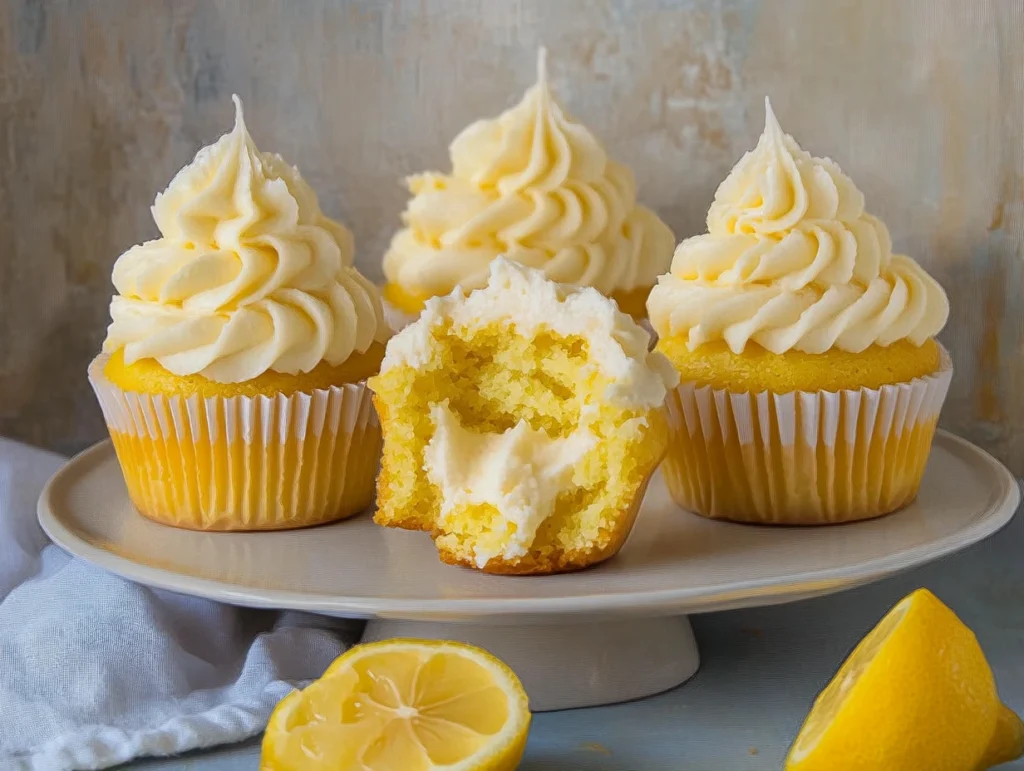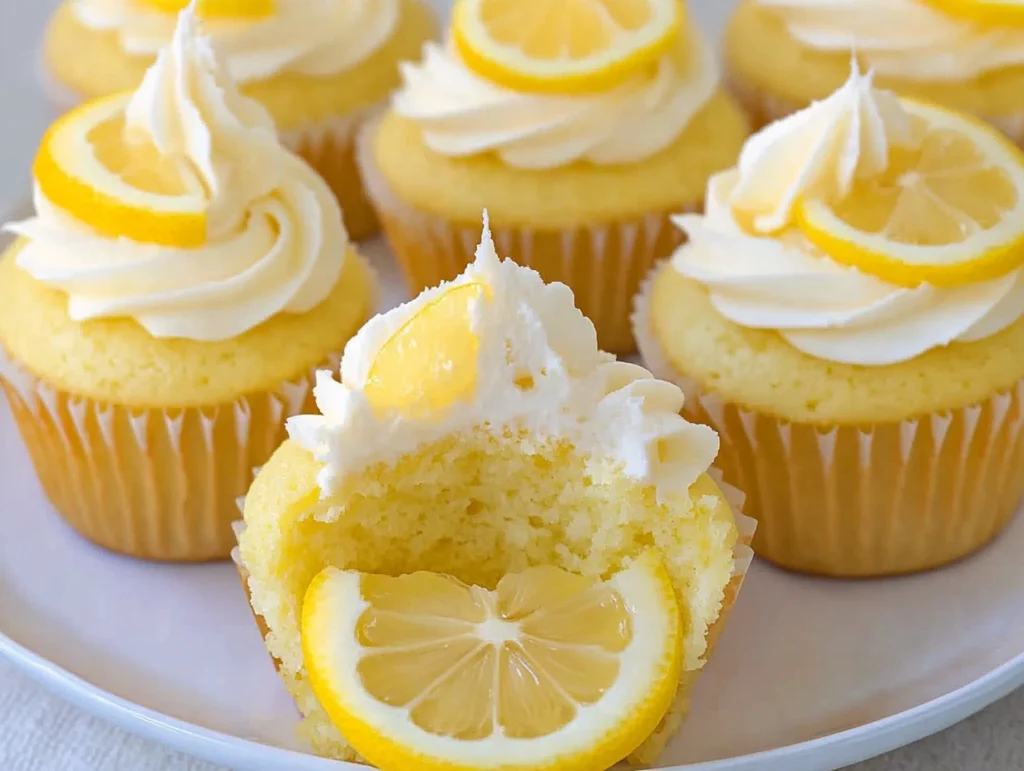Lemon cupcakes are a delightful treat that perfectly balance the tangy zest of fresh lemons with the comforting sweetness of a classic dessert. Whether enjoyed with a cup of tea or as a centerpiece at a party, lemon cupcakes have carved out a special place in the hearts of dessert lovers. Let’s explore their history and what makes them so irresistibly delicious.

The History of Lemon Cupcakes
1. The Evolution of Cupcakes
Cupcakes have been a beloved dessert for centuries, with their origins tracing back to the late 18th century. Initially, they were simple, single-serving cakes baked in small cups, giving them their charming name. Over time, bakers began experimenting with flavors and designs, transforming cupcakes into the versatile and decorative desserts we enjoy today.
2. How Lemon Became a Popular Flavor in Desserts
Lemon has long been a favorite ingredient in culinary traditions around the world, celebrated for its fresh, citrusy aroma and flavor. In desserts, the tartness of lemon provides a refreshing contrast to sweetness, making it a natural choice for cakes, pies, and frostings. Lemon cupcakes emerged as a variation of traditional vanilla cupcakes, quickly gaining popularity for their bright and invigorating taste.
Key Ingredients in Lemon Cupcakes
1. The Role of Fresh Lemons
Fresh lemons are the star ingredient in lemon cupcakes, providing both zest and juice. The zest contains essential oils that add a fragrant citrus aroma, while the juice contributes a tangy flavor that complements the sweetness of the cupcake batter. Using fresh lemons ensures the cupcakes have a vibrant, authentic taste that no artificial flavoring can replicate.
2. Importance of Quality Butter and Sugar
High-quality butter and sugar are essential for creating a rich, moist, and flavorful cupcake. Butter provides a creamy texture and enhances the overall flavor, while sugar balances the tartness of the lemon and helps achieve a tender crumb. Using granulated sugar ensures a smooth batter and evenly distributed sweetness.
3. Choosing the Right Flour
Flour is the foundation of any good cupcake. For lemon cupcakes, all-purpose flour is often the preferred choice because it provides a balance of structure and softness. Sifting the flour before mixing helps aerate it, resulting in lighter, fluffier cupcakes.
Tools You Need to Make Perfect Lemon Cupcakes
1. Essential Baking Tools
To create perfect lemon cupcakes, you’ll need some fundamental baking tools:
- Mixing Bowls: A set of large and medium bowls for preparing the batter and mixing the ingredients.
- Whisk and Spatula: A whisk for combining dry and wet ingredients, and a spatula for folding and scraping.
- Measuring Cups and Spoons: Accurate measurement is crucial in baking to ensure consistent results.
- Electric Mixer: A handheld or stand mixer helps achieve a smooth and well-mixed batter.
- Cupcake Pan and Liners: A standard 12-cup cupcake pan with paper or silicone liners ensures even baking and easy cleanup.
- Cooling Rack: Allows the cupcakes to cool evenly without becoming soggy on the bottom.
2. Optional Tools for Enhanced Results
For those who want to elevate their baking experience:
- Zester: Perfect for extracting fine lemon zest without including the bitter pith.
- Ice Cream Scoop: Ideal for evenly portioning cupcake batter into the liners.
- Piping Bag and Tips: If you want to decorate your lemon cupcakes with frosting, these are great for achieving professional designs.
- Kitchen Scale: Ensures precise ingredient measurements for consistent results, especially for weight-based recipes.

Step-by-Step Recipe for Lemon Cupcakes
1. Preparing the Ingredients
- Gather all the ingredients, ensuring they are at room temperature for easier mixing.
- Zest and juice fresh lemons, measuring the required amounts for both the batter and frosting.
- Sift the dry ingredients, such as flour, baking powder, and a pinch of salt, to remove lumps and aerate the mixture.
2. Mixing Techniques
- Cream the Butter and Sugar: Using an electric mixer, beat softened butter and sugar together until light and fluffy. This step is key to creating airy cupcakes.
- Incorporate Wet Ingredients: Gradually add eggs one at a time, mixing well after each addition. Stir in the lemon zest and juice for a burst of flavor.
- Combine Dry and Wet Ingredients: Alternate adding the dry ingredients and milk to the butter mixture, beginning and ending with the dry ingredients. Mix until just combined to avoid overworking the batter.
3. Baking Tips for the Perfect Texture
- Preheat the Oven: Set the oven to 350°F (175°C) and allow it to fully preheat before placing the cupcakes inside.
- Fill Liners Evenly: Use a scoop or spoon to fill cupcake liners about two-thirds full to prevent overflow.
- Bake Evenly: Place the cupcake pan in the center of the oven for even heat distribution. Bake for 18-20 minutes, or until a toothpick inserted in the center comes out clean.
- Cool Properly: Let the cupcakes cool in the pan for 5 minutes before transferring them to a wire rack to cool completely.
Variations of Lemon Cupcakes
1. Lemon Poppy Seed Cupcakes
Lemon poppy seed cupcakes are a delightful twist on the classic recipe. Adding poppy seeds to the batter introduces a subtle nutty flavor and a pleasant crunch, perfectly complementing the bright lemony notes. These cupcakes are often topped with a tangy lemon glaze or cream cheese frosting to enhance their citrus flavor.
2. Lemon Blueberry Cupcakes
Lemon and blueberry are a match made in dessert heaven. The tartness of fresh or frozen blueberries pairs beautifully with the zesty lemon flavor. Fold blueberries gently into the batter before baking to prevent them from sinking to the bottom. A dollop of blueberry compote on top or a swirl of blueberry-infused frosting adds a stunning visual and flavor enhancement.
3. Gluten-Free Lemon Cupcakes
For those with gluten sensitivities, gluten-free lemon cupcakes offer all the zest without the gluten. Replace all-purpose flour with a gluten-free flour blend, and ensure that all ingredients, including baking powder, are certified gluten-free. These cupcakes are just as light and flavorful as their traditional counterparts, making them a crowd-pleaser for everyone.

The Science Behind Baking Lemon Cupcakes
1. How Acidity Impacts the Batter
Lemon juice is naturally acidic, and its acidity plays a crucial role in baking. It reacts with baking soda or baking powder in the batter, producing carbon dioxide bubbles that help the cupcakes rise and achieve a light, airy texture. However, too much acidity can cause the batter to collapse or result in an overly dense crumb, so balance is key.
2. Balancing Flavors
The success of lemon cupcakes lies in their balanced flavor profile. The tartness of the lemon is countered by the sweetness of sugar, creating harmony in each bite. Adding a pinch of salt can further enhance the natural lemon flavor, while vanilla extract provides a subtle undertone that ties the ingredients together. When crafting variations, consider complementary flavors like blueberries, poppy seeds, or herbs like thyme to elevate the taste without overpowering the lemon essence.
Lemon Frostings and Toppings
1. Cream Cheese Lemon Frosting
Cream cheese lemon frosting is a rich and tangy option that complements the zesty flavor of lemon cupcakes beautifully. The cream cheese adds a smooth, slightly tart base, while lemon zest and juice enhance its citrusy profile. Whipping the frosting until fluffy creates a light texture that’s easy to pipe or spread, making it a favorite for elegant cupcake decorations.
2. Lemon Glaze
Lemon glaze is a simple yet flavorful topping that adds a glossy finish to cupcakes. Made with powdered sugar and fresh lemon juice, this glaze strikes the perfect balance between sweet and tart. Drizzle it over the cupcakes for a casual, rustic look, or dip the tops for a more uniform coating. Adding a pinch of zest to the glaze intensifies the lemon flavor.
3. Creative Toppings for Aesthetics
For an artistic flair, consider these creative toppings:
- Candied Lemon Slices: Thinly sliced lemons cooked in sugar syrup add a beautiful and edible garnish.
- Fresh Fruit: Blueberries, raspberries, or small sprigs of mint provide a pop of color and fresh flavor.
- Edible Flowers: Bright, food-safe blooms like pansies or violas elevate the presentation to a gourmet level.
- Decorative Sugar: Use colored sugar or edible glitter to create a sparkling effect.
Tips for Baking Lemon Cupcakes Like a Pro
1. Common Mistakes to Avoid
- Overmixing the Batter: Mixing too much can develop gluten in the flour, resulting in dense cupcakes. Mix until just combined.
- Using Bottled Lemon Juice: Fresh lemon juice provides a vibrant, authentic flavor that bottled juice lacks.
- Overbaking: Keep a close eye on the cupcakes, as overbaking can dry them out. Remove them from the oven as soon as a toothpick inserted in the center comes out clean.
- Skipping Room Temperature Ingredients: Cold butter, eggs, or milk can cause the batter to curdle and affect the cupcake’s texture.
2. Enhancing Flavor Through Zest and Juice
- Use Both Zest and Juice: Lemon zest contains essential oils that deliver intense citrus aroma, while the juice contributes tangy flavor. Incorporating both ensures a balanced lemony taste.
- Infuse the Butter or Sugar: Rubbing lemon zest into the sugar or melting it with the butter before mixing distributes the citrus flavor more evenly throughout the batter.
- Boost with Extracts: For an extra punch of flavor, add a small amount of lemon extract or vanilla extract to the batter or frosting.
Frequently Asked Questions (FAQs) About Lemon Cupcakes
1. Why Are My Cupcakes Dense?
Dense cupcakes are often the result of overmixing the batter, which develops too much gluten in the flour. Other reasons may include using cold ingredients, insufficient leavening agents, or overbaking. To avoid this, mix until just combined, use room-temperature ingredients, and ensure accurate measurements of baking powder or soda.
2. How to Ensure a Strong Lemon Flavor?
To achieve a robust lemon flavor, use both fresh lemon zest and juice in the batter and frosting. For an extra punch, add a small amount of lemon extract. Infusing sugar with zest or incorporating lemon curd into the recipe can also amplify the citrus flavor.
3. Can I Use Bottled Lemon Juice?
While bottled lemon juice can be a convenient substitute, it lacks the vibrant, fresh flavor of freshly squeezed lemon juice. If you must use bottled juice, opt for a high-quality brand with minimal preservatives to preserve some of the citrus essence.
4. How Do I Make Vegan Lemon Cupcakes?
To make vegan lemon cupcakes:
- Substitute dairy milk with plant-based milk (like almond or soy milk).
- Use vegetable oil or vegan butter in place of traditional butter.
- Replace eggs with a vegan alternative, such as applesauce, flaxseed meal mixed with water, or a store-bought egg replacer.
These adjustments will ensure moist, flavorful cupcakes that are free of animal products.
5. Can I Freeze Lemon Cupcakes?
Yes, lemon cupcakes freeze well. Allow them to cool completely, then wrap each cupcake tightly in plastic wrap or store them in an airtight container. Frosting can also be frozen separately. When ready to enjoy, thaw the cupcakes at room temperature and add the frosting just before serving.
6. How Do I Prevent the Frosting From Melting?
To keep frosting from melting:
- Avoid frosting cupcakes while they’re still warm. Let them cool completely.
- Use stabilized frosting, such as one made with cream cheese or butter, and store the cupcakes in a cool, dry place.
- For warm environments, refrigerate the cupcakes and bring them to room temperature before serving.
7. What Is the History of Lemon Cupcakes?
The history of lemon cupcakes ties into the evolution of cupcakes themselves, which originated in the 18th century as single-serving cakes baked in small cups. Lemon became a popular flavor in desserts over time due to its refreshing taste and ability to balance sweetness, making lemon cupcakes a beloved variation of the classic treat.
8. Did Hostess Discontinue Lemon Cupcakes?
Hostess has periodically released limited-edition lemon-flavored cupcakes as part of their snack cake lineup. While these cupcakes are not always a permanent offering, they may be brought back seasonally or in response to consumer demand. Check with Hostess for current availability.
9. What Is the Secret to Super Moist Cupcakes?
The key to super moist cupcakes is ensuring the right balance of fats and liquids in the batter. Use room-temperature butter or oil, don’t overmix, and avoid overbaking. Adding a touch of sour cream, yogurt, or buttermilk can enhance moisture levels.
10. Why Do My Lemon Cupcakes Sink in the Middle?
Cupcakes may sink due to several reasons:
- Overmixing the batter, which incorporates too much air.
- Opening the oven door too early, causing a sudden temperature drop.
- Insufficient baking time or an underheated oven.
To prevent this, mix the batter gently, bake in a fully preheated oven, and avoid disturbing the cupcakes during baking.
In the section about baking tips, reference the Banana Bread with Sour Cream Recipe to illustrate how ingredients like sour cream can enhance moisture and flavor.For creative frosting and topping ideas, link to the Brown Butter Chocolate Chip Cookies article to discuss how techniques like browning butter can add depth to frosting.
Conclusion
Lemon cupcakes are a timeless dessert that brings together the tangy brightness of lemons and the comforting sweetness of a classic treat. From understanding their history to mastering the art of baking and decorating, every aspect contributes to creating a delightful culinary experience. By exploring variations, perfecting techniques, and experimenting with frostings and toppings, you can customize lemon cupcakes to suit any occasion or preference. Whether you’re a seasoned baker or a beginner, these tips and insights ensure your lemon cupcakes will be as beautiful as they are delicious. With the right tools, ingredients, and a dash of creativity, your lemon cupcakes will leave a lasting impression on everyone who takes a bite!

